ADC DC Measurement
Measure DC performance metrics of ADC output
Libraries:
Mixed-Signal Blockset /
ADC /
Measurements & Testbenches
Description
The ADC DC Measurement block measures ADC DC performance metrics such as offset error, gain error, integral nonlinearity (INL), and differential nonlinearity (DNL). You can use ADC DC Measurement block to validate the ADC architectural models provided in Mixed-Signal Blockset™, or you can use an ADC of your own implementation.
Ports
Input
Analog input signal to ADC block, specified as a scalar.
Data Types: double
External conversion start clock, specified as a scalar. The analog to digital conversion process starts at the rising edge of the signal at the start port.
Data Types: double
Converted digital signal from an ADC, specified as a scalar.
Data Types: fixed point | single | double | int8 | int16 | int32 | uint8 | uint16 | uint32
Indicates whether the analog to digital conversion is complete, specified as a scalar.
Data Types: double
Parameters
Dynamic range of the ADC, specified as a 2-element vector in V. The two vector elements represent the minimum and maximum values of the dynamic range, from left to right.
Programmatic Use
Use
get_param(gcb,'InputRange')to view the current value of Input range.Use
set_param(gcb,'InputRange',value)to set Input range to a specific value.
Delays measurement analysis to avoid corruption by transients, specified as a nonnegative real scalar in seconds.
Programmatic Use
Use
get_param(gcb,'HoldOffTime')to view the current value of Hold off time.Use
set_param(gcb,'HoldOffTime',value)to set Hold off time to a specific value.
Number of physical bits in ADC, specified as a unitless positive real integer. Number of bits must match the resolution specified in the ADC block.
Programmatic Use
Use
get_param(gcb,'NBits')to view the current Number of bits.Use
set_param(gcb,'NBits',value)to set Number of bits to a specific value.
Frequency of the start conversion clock of the ADC, specified as a positive real scalar in hertz. Start conversion frequency must match the frequency of the start conversion clock of the ADC block. This parameter is used to calculate Recommended simulation stop time.
Programmatic Use
Use
get_param(gcb,'Frequency')to view the current value of Start conversion frequency.Use
set_param(gcb,'Frequency',value)to set Start conversion frequency to a specific value.
Minimum time the simulation must run to obtain meaningful results, specified as a positive real scalar in seconds.
For DC measurement, the simulation must run so that ADC can sample each digital code
10 times with the default error tolerance of 0.1, assuming a ramp
input that traverses the full scale range of the ADC over the period of simulation.
Based on this assumption, the analog input frequency
(fanalog), generated by the ADC Testbench
block for the sawtooth waveform is set as:
where StartFreq is the frequency of the conversion start clock and Nbits is the resolution of the ADC.
So, the Recommended min. simulation stop time (s) (T) is calculated by using the formula: .
Data Types: double
Click to automatically set the Recommended min. simulation stop time (s) as the stop time of the Simulink® model.
Measure the differential nonlinearity (DNL) error and integral nonlinearity (INL) error using the endpoint method. This method uses the end points of the actual transfer function to measure the DNL and INL error.
Measure the differential nonlinearity (DNL) error and integral nonlinearity (INL) error using the best fit method. This method uses a standard curve fitting technique to find the best fit to measure the DNL and INL error.
Store detailed test results to a struct in the base workspace for
further processing. By default, this option is not selected.
Name of the variable that stores detailed test results, specified as a character string.
Dependencies
This parameter is only available when Output result to base workspace is selected
Programmatic Use
Use
get_param(gcb,'VariableName')to view the current value of Workspace variable name.Use
set_param(gcb,'VariableName',value)to set Workspace variable name to a specific value.
Click to plot measurement result for further analysis.
More About
Offset error represents the offset of the ADC transfer function curve from it ideal value at a single point.
Gain error represents the deviation of the slope of the ADC transfer function curve from its ideal value.
Integral nonlinearity (INL) error, also termed as relative accuracy, is the maximum deviation of the measured transfer function from a straight line. The straight line is can be a best fit using standard curve fitting technique, or drawn between the end points of the actual transfer function after gain adjustment.
The best fit method gives a better prediction of distortion in AC applications, and a lower value of linearity error. The endpoint method is mostly used in measurement application of data converters, since the error budget depends on the actual deviation from ideal transfer function.
Differential nonlinearity (DNL) is the deviation from the ideal difference (1 LSB) between analog input levels that trigger any two successive digital output levels. The DNL error is the maximum value of DNL found at any transition.
Version History
Introduced in R2019a
See Also
MATLAB Command
You clicked a link that corresponds to this MATLAB command:
Run the command by entering it in the MATLAB Command Window. Web browsers do not support MATLAB commands.
选择网站
选择网站以获取翻译的可用内容,以及查看当地活动和优惠。根据您的位置,我们建议您选择:。
您也可以从以下列表中选择网站:
如何获得最佳网站性能
选择中国网站(中文或英文)以获得最佳网站性能。其他 MathWorks 国家/地区网站并未针对您所在位置的访问进行优化。
美洲
- América Latina (Español)
- Canada (English)
- United States (English)
欧洲
- Belgium (English)
- Denmark (English)
- Deutschland (Deutsch)
- España (Español)
- Finland (English)
- France (Français)
- Ireland (English)
- Italia (Italiano)
- Luxembourg (English)
- Netherlands (English)
- Norway (English)
- Österreich (Deutsch)
- Portugal (English)
- Sweden (English)
- Switzerland
- United Kingdom (English)
